The allure of pickleball has spread like wildfire, captivating both young novices and seasoned athletes across the globe. A blend of tennis, badminton, and ping-pong, this sport’s unique dynamics and spirited gameplay are facilitated by precise court constructions. Understanding the nuances of a pickleball court from its standard dimensions to the meticulous markings is paramount for a seamless and enjoyable experience, whether for recreation or competition. In this guide, Picklenlife will delves into the intricate details of pickleball court dimensions and layout, critical construction materials, and essential accessories, cementing our understanding of this thrilling sport. Brace yourself for an immersive journey into the world of pickleball courts, where each specification and regulation enhances the vibrancy and fairness of the game.
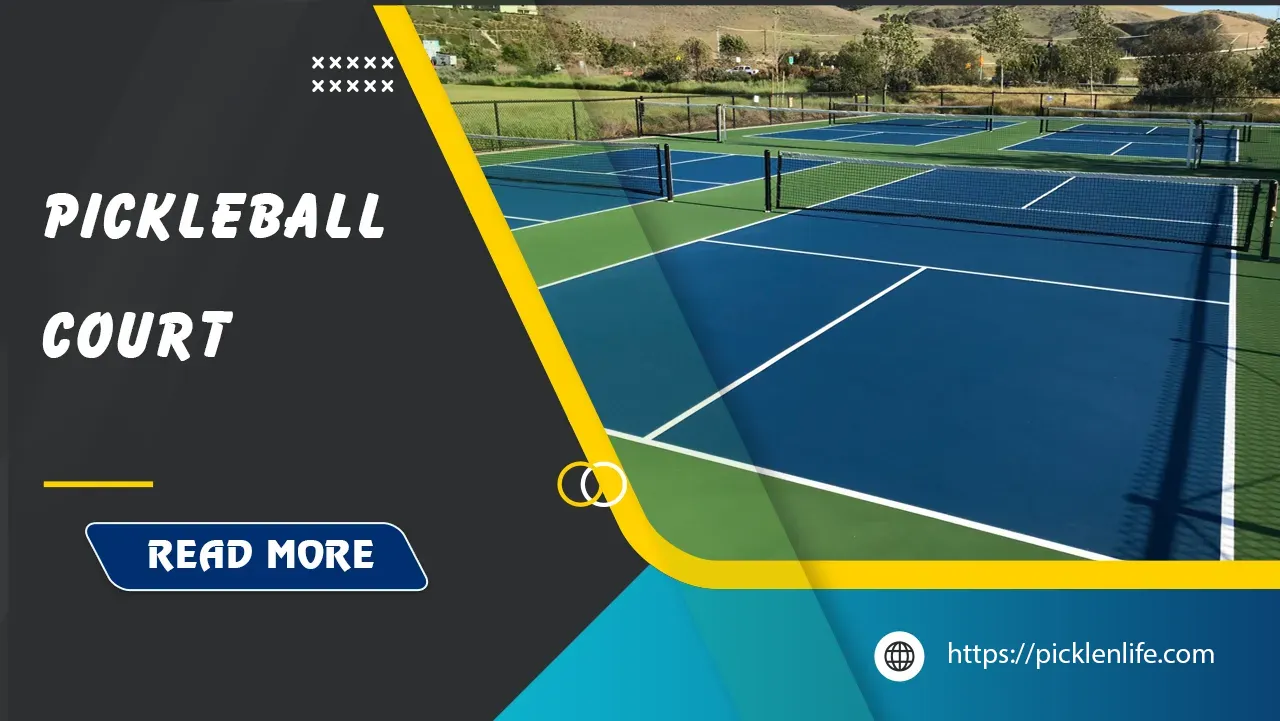
Dimensions
Ensuring the correct dimensions of a pickleball court is akin to crafting a masterpiece. Just as an artist meticulously considers each stroke, every inch of the court matters for maintaining the game’s integrity and excitement. A pickleball court measures 44 feet (13.41 meters) long and 20 feet (6.1 meters) wide, similar to a well-designed theater where every seat provides a perfect view, offering an optimal balance for both singles and doubles play. This space expands from the precise net height, which is 36 inches (0.914 meters) at the sidelines and 34 inches (0.864 meters) at the center, echoing the need for symmetry and balance in performance arts.

Standard Court Size
The standard court size for pickleball is indeed a confluence of precision and tradition, revered by enthusiasts and professionals alike. The court spans a length of 44 feet (13.41 meters) and a width of 20 feet (6.1 meters), regardless of whether it caters to singles or doubles matches. Imagine this space as a dance floor where every movement is calculated and strategic, ensuring an optimal environment for skillful play. The total area, at 880 square feet (81.7 square meters), invites players into a theater of agility and strategy.
A quintessential element of the court is the net, which stands sentry at 36 inches (0.914 meters) high at the sidelines and dips slightly to 34 inches (0.864 meters) at the center. This subtle variation symbolizes the peaks and troughs of a competitive game, ensuring the ball’s trajectory remains both challenging and fair. The net’s height is meticulously regulated to permit smooth ball clearance while safeguarding the essence of the game.
Crucial to the court’s function are the recommended play areas around the court itself. For optimal movement and high-quality play, a space of at least 30 feet by 60 feet is recommended, while a more expansive area of 34 feet by 64 feet offers even greater comfort. These additional dimensions provide a buffer that allows players to execute dynamic moves and thrilling shots, without the constraint of close boundaries a haven for exhilarating rallies.
To render this vision tangible, here’s a summary table:
| Specification | Standard Measurement |
|---|---|
| Length | 44 feet (13.41 meters) |
| Width | 20 feet (6.1 meters) |
| Net Height at Sidelines | 36 inches (0.914 meters) |
| Net Height at Center | 34 inches (0.864 meters) |
| Total Area | 880 sq ft (81.7 sq m) |
| Recommended Total Space | 30 x 60 feet (9.14 x 18.29 meters) |
| Preferred Total Space | 34 x 64 feet (10.36 x 19.51 meters) |
These specifications constitute a regulation-sized court, endorsed by the USA Pickleball Association, ensuring fair play and standardized conditions whether you’re delving into a casual match or an intense championship.
Non-Volley Zone Specifications
At the heart of strategic pickleball play lies the non-volley zone, affectionately known as the “kitchen.” This 7-foot extension from the net on both sides is more than just a boundary; it is a vital element that shapes gameplay dynamics. Think of it as a culinary workspace where the finesse of each move is paramount.
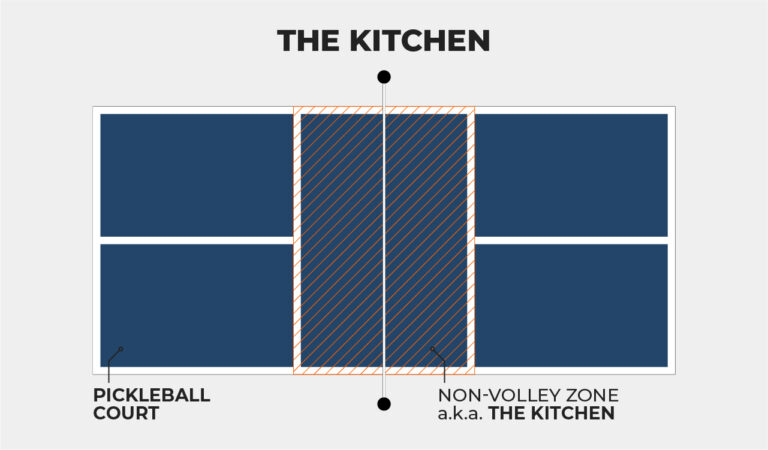
The non-volley zone stretches 14 feet across the court, with each side gaining 7 feet from the net. This critical area enforces unique rules that compel players to sharpen their strategic aptitude. Players are free to step into this zone to hit a ball that has bounced, but they are restricted from executing a volley hitting the ball before it touches the ground while standing inside or if their momentum takes them into the zone post-volley. This restriction discourages aggressive net play, urging participants to plan their moves with surgical precision.
A detailed understanding of this zone is essential:
| Specification | Measurement |
|---|---|
| Length from the Net | 7 feet (2.13 meters) |
| Total Width | 14 feet (4.27 meters) |
| Bounce Play Allowed | Yes |
| Volley Play Allowed | No |
The non-volley zone thus fosters a dance of dexterity and patience, where players must calibrate their steps, ensuring they do not breach the guidelines. This zone is a bastion of fair play, emphasizing the sport’s underlying ethos of strategy over brute force. It’s an area where skill and precision take precedence, enhancing the game’s richness and intensity.
Imagine the non-volley zone as a river in the dance of pickleball, guiding the flow of the game and necessitating thoughtful navigation. It is a sanctuary for finely-calibrated strokes and strategic plays, ensuring that each match is a testament to skill and strategy, rather than mere power.
Service Zones
The service zones on a pickleball court are akin to launchpads, initiating every rally with precision and flair. Each service zone measures 10 feet wide and 15 feet deep, meticulously delineating the space from where serves propel the match into action.
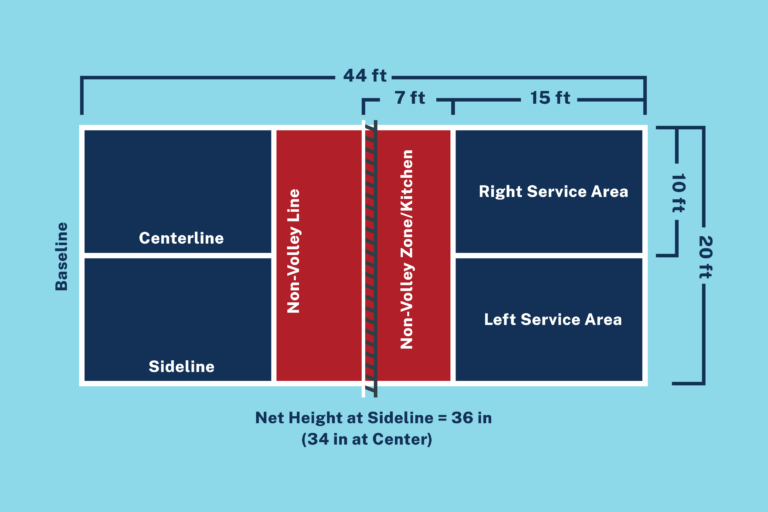
These zones are compartmentalized by a centerline, dividing the court into left and right service areas. Players serve diagonally, into their opponents’ respective service zones. This division ensures that every serve is a calculated endeavor, fostering consistency and fairness in gameplay.
Service Zone Specifications:
| Specification | Measurement |
|---|---|
| Width of Service Zone | 10 feet (3.05 meters) |
| Depth of Service Zone | 15 feet (4.57 meters) |
| Diagonal Serve Requirement | Yes |
| Division Line | Centerline |
Positioned beyond the non-volley zone and reaching to the baseline, these service areas are the starting grounds for each rally. The precise placement of these zones guides the flow of play, demanding accuracy and strategic foresight from players as they serve.
The configuration of service zones:
- Non-Volley Zone (7 feet from the net)
- Service Zones (10 feet wide by 15 feet deep)
- Baseline (marking the furthest boundary for serves)
Envision these zones as gateways to the dynamic exchanges in pickleball, where each serve must navigate through the precise lanes, propelling the game forward with each calculated shot. The service zones aren’t merely areas on the court; they are the springboards that bring the game to life, demanding both precision and tactical awareness, thus enhancing both gameplay and the immersive experience of the sport.
Layout
The layout of a pickleball court is as structured and harmonious as a symphony, with each component playing a vital role in creating a coherent and enjoyable game. From the baseline at the back to the non-volley zone (kitchen) near the net, every line and mark has a purpose, much like notes on a musical sheet. Properly understanding and consistently applying these elements guarantees not only the adherence to official regulations but also the enhancement of the playing experience itself.
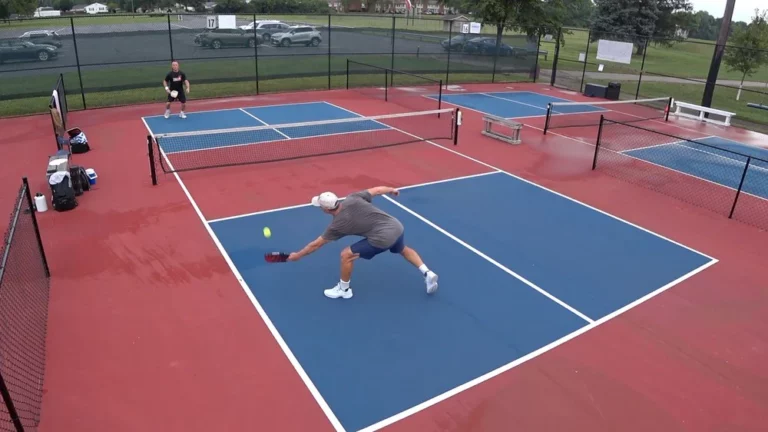
Court Markings
Court markings are akin to a painter’s brush strokes on a canvas, defining spaces and enhancing gameplay with their precision. The lines on a pickleball court establish boundaries and zones that are essential for play, ensuring clarity and fairness.
Essential Markings Include:
- Baseline: This line runs parallel to the net at the back of the court and defines the limit for serves and long shots. Any ball landing beyond this line is considered out.
- Non-Volley Zone Line (Kitchen Line): Marked 7 feet from the net, this line demarcates the no-volley zone, where players cannot volley.
- Sidelines: Running perpendicular to the net, these lines define the lateral limits of the court.
- Service Line: These lines, split by a centerline, mark the service zones.
- Centerline: Divides the service area into left and right sections, guiding players on where to serve.
Court Marking Specifications:
| Marking | Measurement |
|---|---|
| Baseline | Court Width (20 feet) |
| Non-Volley Line | 7 feet from the net |
| Sidelines | Court Length (44 feet) |
| Service Line | 15 feet from the net |
| Centerline | Divides service areas |
Materials for marking include court marking tapes for temporary lines or durable paint for permanent setups. Properly selected and maintained line markings enhance visibility and accuracy of calls during the game, ensuring an equitable playing field.
Net Height Regulations

The net height in pickleball is a meticulously regulated aspect that ensures standardized gameplay. Set at 36 inches at the sidelines and dipping slightly to 34 inches at the center, the net’s height creates a fundamental axis for the sport.
| Specification | Measurement |
|---|---|
| Net Height at Sidelines | 36 inches (0.914 meters) |
| Net Height at Center | 34 inches (0.864 meters) |
This seemingly minor difference in height aids in maintaining fair play and allows for the optimal flight of the ball. The consistency of these net heights across all sanctioned courts ensures that players compete within an even framework, regardless of location. The net’s integrity is paramount, likened to the string tension in a musical instrument, subtly influencing the game’s rhythm and harmony.
Exterior Lines and Boundaries
The exterior lines on a pickleball court are the sentinels that uphold the boundaries of play. Each line delineates the playfield’s limits, maintaining order and ensuring fair gameplay. The standard court dimensions of 20 feet by 44 feet are defined by these exterior lines, typically painted with high visibility colors like white or yellow.
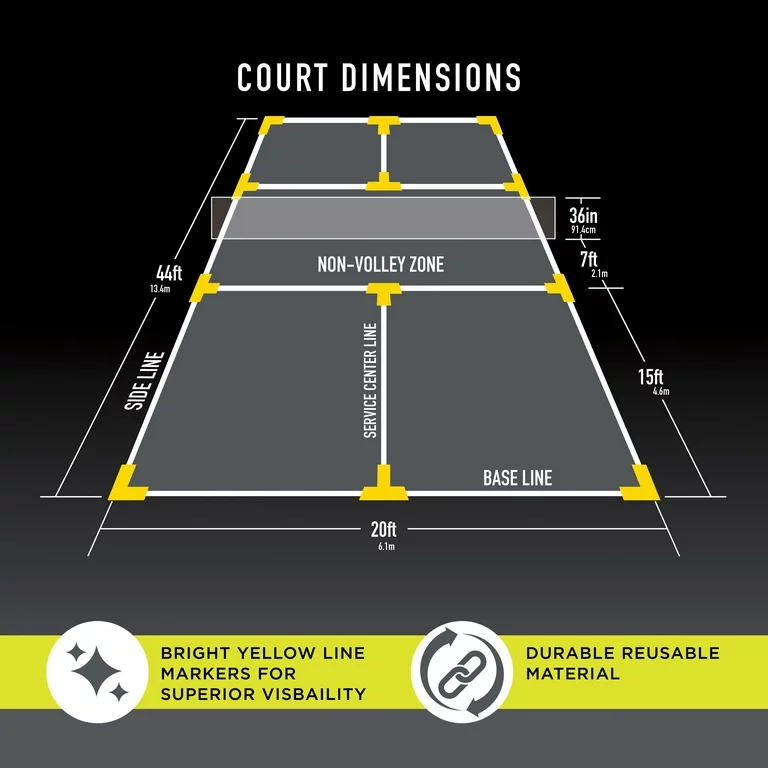
Crucial Exterior Lines:
| Line Type | Measurement |
|---|---|
| Baselines | 20 feet (court width) |
| Sidelines | 44 feet (court length) |
| Non-Volley Zone | 7 feet from the net |
| Centerline | Divides service areas |
Exterior lines must be precisely marked at 2 inches wide to ensure they are prominent and visible. They anchor the gameplay, much like the support structures in a building, providing a clear framework within which players can maneuver and strategize. Their proper placement and bright visibility are essential to avoid disputes and ensure smooth gameplay transitions.
Construction
Building a pickleball court requires a meticulous selection of materials and a structured approach to ensure the longevity and quality of the playing surface. From choosing the right surface material to following detailed building guidelines, this section covers the essentials for constructing both permanent and temporary pickleball courts.
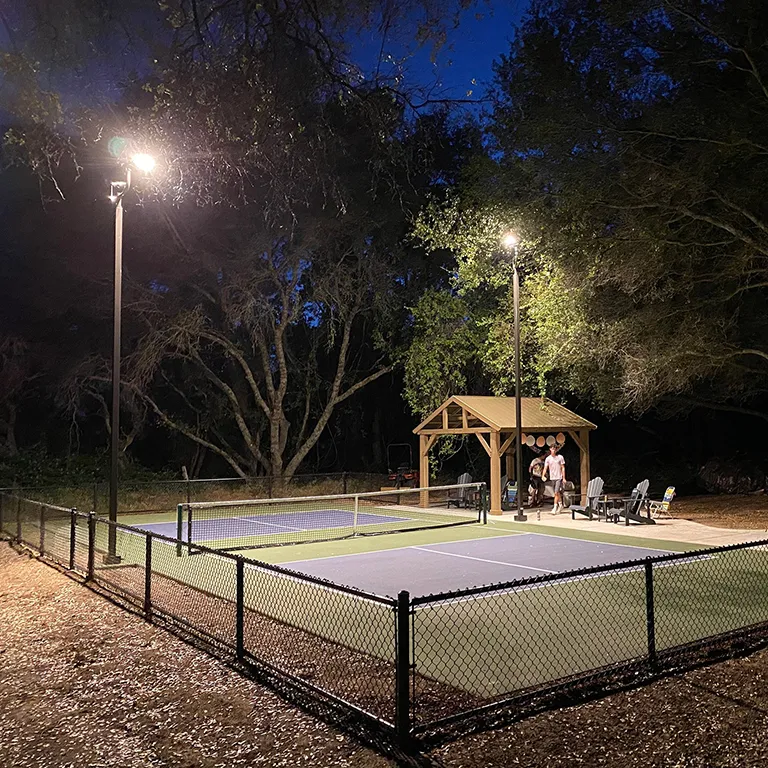
Materials for Court Surface
Selecting the right material for the pickleball court surface is pivotal for ensuring optimal playability and durability. Just as a foundation defines the strength of a skyscraper, the surface material of a pickleball court establishes the quality of play.
Common Surface Materials:
- Asphalt: Popular for outdoor courts due to its affordability and smooth surface. It requires regular maintenance to prevent cracks.
- Concrete: Known for its durability and even surface, concrete is often enhanced with acrylic coatings to improve traction and cushion.
- Polyurethane: Used mainly for indoor courts, this material offers excellent shock-absorption but comes with a higher cost.
- Clay: While less common, clay provides excellent shock-absorption and is easier on joints but requires more maintenance.
- Grass: Typically used for recreational spaces rather than professional play due to its variable surface.
Surface Material Comparison:
| Material | Durability | Playability | Maintenance |
|---|---|---|---|
| Asphalt | Medium | High | Regular |
| Concrete | High | High | Low |
| Polyurethane | High | High | Medium |
| Clay | Medium | Medium | High |
| Grass | Low | Low | High |
Building Guidelines for Permanent Courts
Constructing permanent pickleball courts involves adherence to specific guidelines to ensure they meet regulatory standards and provide a high-quality playing surface.
Key Guidelines Include:
- Dimensions: Adhere to the standard dimensions (20 feet wide by 44 feet long) and ensure a minimum surrounding space of 30 feet by 60 feet.
- Surface Materials: Select durable materials like asphalt or concrete for outdoor courts, and wood or rubber for indoor courts.
- Noise Mitigation: Implement strategies to reduce noise, especially in residential areas.
- Additional Features: Include fencing, lighting, and required accessories for optimal play. Ensure proper drainage and surface friction for safety.
- Professional Standards: Follow the comprehensive construction manual by the American Sports Builders Association and guidelines from USA Pickleball.
Temporary Court Setup
Setting up temporary pickleball courts requires flexibility and precision to ensure they meet standard specifications while utilizing existing spaces efficiently.
Steps for Temporary Setup:
- Surface Options: Utilize solid existing surfaces like tennis courts, basketball courts, or asphalt roads.
- Accurate Marking: Use temporary materials like court tape or chalk to mark the court dimensions.
- Proper Alignment: Ensure the court is correctly aligned, avoiding sun glare for north-south orientated existing surfaces.
- Surface Maintenance: Regularly check and maintain the existing surface to prevent damage and ensure a safe play area.
- Ownership Permission: Obtain consent from facility owners and test markings in small areas before full application.
These steps ensure that both temporary and permanent pickleball courts are built to standard, providing players with high-quality, safe, and enjoyable playing environments.
Accessories
Pickleball court accessories play a vital role in enhancing the playing experience and ensuring the court is fully equipped for practice and competitive play. From the nets that delineate the playing area to lighting that ensures visibility, each accessory is integral to the game.
Pickleball Nets
The net is the centerpiece of a pickleball court, defining the playing area and enabling fair gameplay. A standard pickleball net measures 22 feet wide and stands 36 inches high at the sidelines, dipping to 34 inches at the center.
Key Aspects Include:
- Regulation Size: Ensures that the net meets official standards, providing a consistent playing experience.
- Durability: High-quality nets made of robust materials like nylon or polyester are crucial for longevity.
- Portable Systems: Portable nets with sturdy frames offer flexibility and can be easily set up and taken down, making them ideal for varied locations. They are often constructed with metal or composite materials for durability.
- Installation and Maintenance: Regular checks and proper tension adjustment are essential for maintaining the net’s condition and ensuring it remains at the correct height.
Investing in regulation-size nets ensures high-quality play, whether for casual practice or competitive matches.
Court Lighting Options
Proper lighting is crucial for visibility during evening play, enhancing both the safety and enjoyment of the game.
- LED Lighting: Highly recommended for its energy efficiency and bright illumination, LED lights provide uniform lighting with minimal glare.
- Pole-Mounted Lights: Positioning lights on tall poles around the court ensures even light distribution and reduces shadows.
- Floodlights: Powerful floodlights positioned at elevated points provide comprehensive coverage, eliminating dark spots.
- Solar-Powered: Eco-friendly solar-powered lights harness sunlight to reduce electricity costs and ensure illumination.
Court Lighting Specifications:
| Lighting Type | Benefits |
|---|---|
| LED Lighting | Energy-efficient, bright |
| Pole-Mounted | Even light distribution |
| Floodlights | Powerful, comprehensive |
| Solar-Powered | Eco-friendly, cost-saving |
Proper lighting enhances nighttime play, ensuring a well-lit, safe environment.
Fencing for Safety
Fencing around a pickleball court is essential for containing the ball, ensuring player safety, and enhancing the playing environment.
- Padded Fences: Installing padding on fence posts and rails minimizes the risk of injury.
- Windscreens: Reduce wind interference and provide added privacy and visibility.
- Ball Stop Netting: Helps contain stray balls, reducing the need for frequent retrieval.
- Gate Safety Mechanisms: Self-closing and self-latching gates enhance security, keeping them closed unintentionally.
Fencing Enhancements:
| Accessory | Benefit |
|---|---|
| Padded Fences | Injury prevention |
| Windscreens | Wind reduction, privacy |
| Ball Stop Netting | Contains stray balls |
| Gate Safety | Enhances security and convenience |
By selecting the right accessories, court owners can create a secure, enjoyable environment for players.
Maintenance
Regular maintenance is crucial for preserving the quality and safety of pickleball courts. This involves cleaning, inspecting, and addressing any damages promptly.
Surface Care and Cleaning
Cleaning Practices:
- Routine Sweeping: Remove debris regularly using brooms or leaf blowers to maintain a clean surface.
- Pressure Washing: For deep cleaning, use pressure washing with caution to avoid surface damage.
- Stain Removal: Use appropriate cleaning solutions for mold, mildew, and other specific stains.
Surface Care:
- Crack Management: Inspect and fill cracks promptly to prevent further damage.
- Resurfacing: Schedule resurfacing every 3-5 years based on usage and wear.
- Repainting Lines: Maintain the visibility of court lines through regular touch-ups.
| Maintenance Task | Frequency |
|---|---|
| Sweeping | Weekly |
| Pressure Washing | As needed |
| Crack Filling | Promptly when spotted |
| Resurfacing | Every 3-5 years |
| Repainting Lines | As needed |
Implementing these practices ensures longevity and safe play conditions.
Line Marking Techniques
Effective line marking is crucial for clear boundaries and fair gameplay.
Techniques:
- Preparation: Clean the court surface and repair any damages before marking.
- Materials: Use high-quality, weather-resistant paint for permanent lines; court tape for temporary lines.
- Marking Process: Measure dimensions accurately, use straight edges for clean lines, and double-check alignments.
| Line Marking Material | Suitability |
|---|---|
| Paint | Permanent installations |
| Tape | Temporary setups |
Regular inspection and touch-ups maintain the clarity and accuracy of court lines.
Seasonal Maintenance Tips
Adapt maintenance practices to seasonal changes to protect the court surface.
Winter Care:
- Debris Removal: Prevent stains and damage by removing debris regularly.
- Protective Covering: Use tarpaulins to coverthe court during snow or rainy weather. This preserves the integrity of the lines and playing surface.
Spring and Summer Care:
- Regular Cleaning: Increased play usually leads to more wear and tear. Regularly clean and sweep the court to maintain a pristine playing area.
- Inspect for Damage: Look out for any signs of cracking or fading lines due to heat or extensive use. Engage in touch-up painting and minor crack repairs as needed.
- Reapply Anti-Slip Coating: For courts with anti-slip coatings, consider reapplying these during early spring to ensure player safety throughout the summer months.
Seasonal Maintenance Schedule:
| Season | Maintenance Tasks |
|---|---|
| Winter | Debris Removal, Protective Covering |
| Spring | Clean Surface, Inspect for Damage |
| Summer | Frequent Cleaning, Anti-Slip Reapplication |
| Fall | Prepare for Winter, Repair as Needed |
By adhering to these seasonal maintenance tips, you preserve the court’s quality and ensure a safe, enjoyable playing environment year-round.
Conversion
With the growing popularity of pickleball, converting existing spaces like tennis courts into pickleball courts can be an efficient and economical way to accommodate this sport. The conversion process is meticulous, ensuring that the new courts meet official specifications and offer a quality playing experience.
Adapting Tennis Courts for Pickleball
Converting a tennis court for pickleball involves understanding the dimensional differences and implementing precise adjustments.
Conversion Steps:
- Dimension Assessment: A standard tennis court measures 60 feet wide by 120 feet long. A pickleball court is smaller, at 20 feet wide and 44 feet long. This size allows for multiple pickleball courts within a single tennis court.
- Multiple Courts: Typically, you can fit up to four pickleball courts on one tennis court by carefully dividing the space. This setup maximizes the utility of the existing infrastructure.
- Net Adjustment: Lower the tennis net from 36 inches to the pickleball standard of 34 inches at the center. If the existing net can’t be modified, use portable nets designed for pickleball.
Below is a sample layout:
| Tennis Court Conversion | Number of Pickleball Courts |
|---|---|
| Single Tennis Court | Up to 4 Pickleball Courts |
| Net Height Adjustment | 36 inches to 34 inches |
Benefits:
- Increased Usage: Converting underused tennis courts can boost community engagement by offering more opportunities for recreational activities.
- Cost Efficiency: This conversion is significantly cheaper than constructing new courts from scratch, making it a preferred choice for communities.
- Better Space Utilization: Multiple pickleball courts can attract a broader demographic, including both children and older adults, thus fostering community spirit.
Communities that have successfully implemented these conversions have seen increased participation and satisfaction, illustrating the benefits of adapting tennis courts for pickleball.
Setting Up Indoor Courts
Indoor pickleball courts offer versatility and can be a great way to provide a year-round playing environment, unaffected by weather conditions.
Conversion Process:
- Space Evaluation: Assess the available indoor space – whether it’s a gymnasium or a multi-purpose hall. Measure to ensure it can support the standard pickleball dimensions.
- Surface Selection: Choose a surface appropriate for pickleball. Wooden or rubberized flooring is common indoors for their shock-absorbent properties.
- Marking Lines: Use durable, non-slip floor tape or paint to mark the dimensions. Ensure the markings are clear and follow the official guidelines – 20 feet wide and 44 feet long.
- Portable Nets: Set up portable nets that meet regulation height, ensuring they are stable and secure for gameplay.
- Lighting: Indoor facilities must have adequate lighting. LED lights are preferred for their bright, consistent output and energy efficiency.
Example Configurations:
| Indoor Space | Number of Pickleball Courts |
|---|---|
| Full Gymnasium | 4 to 6 Courts |
| Single Basketball Court | 3 Courts |
Benefits:
- Weather Independence: Indoor courts allow for consistent play regardless of weather.
- Extended Playtime: With proper indoor lighting, pickleball games can continue well into the evening.
- Versatile Use: Schools and community centers can transform basketball or volleyball courts into pickleball courts, maximizing facility use.
Having indoor pickleball courts extends the sport’s reach and enhances community engagement, offering a reliable and versatile play space.
Multi-Court Configurations
Optimizing space for multi-court configurations is ideal for hosting tournaments and facilitating community events.
Configurations:
- Side-by-Side Alignment: Arrange courts side-by-side, ensuring ample space (at least 10 feet) between them. This configuration is ideal for large gymnasiums or sports facilities.
- Diagonal Alignment: In some spaces, diagonal alignment can maximize the number of courts by minimizing dead space. This can be particularly useful in irregularly shaped areas.
Setup Considerations:
- Court Spacing: Ensure sufficient space between courts to prevent interference from adjacent games and provide safe walking paths.
- Unified Markings: Clearly mark each court with distinct colors to avoid confusion.
- Common Amenities: Centralize amenities like water stations and seating areas to serve multiple courts efficiently.
Example:
| Facility Type | Number of Pickleball Courts |
|---|---|
| Large Multi-Purpose Hall | 8-10 Courts |
| Double Basketball Court | 6-8 Courts |
Benefits:
- Efficiency: Multi-court setups allow for numerous simultaneous games, making them ideal for league play and tournaments.
- Community Involvement: These configurations cater to large groups, fostering a sense of community among participants.
By leveraging strategic configurations, facilities can host events, tournaments, and casual play sessions seamlessly, making the most of every square inch.
Playing Experience
The overall playing experience on a pickleball court is significantly influenced by its design, accessories, and safety considerations. An optimal playing environment is not just about maintaining the court well but also incorporating safety measures and amenities that enhance gameplay and enjoyment for all participants.
Safety Considerations
Ensuring player safety is paramount in pickleball, minimizing risks and fostering a worry-free environment.
Key Safety Tips:
- Preventing Slips and Falls:
- Inspect the court regularly for any debris or liquid.
- Use slip-resistant shoes designed for court sports.
- Warm-Up and Cool Down:
- Engage in proper warm-up routines to prevent strains and injuries.
- Incorporate stretching exercises pre and post-game for muscle flexibility.
- Playing Area Awareness:
- Stay conscious of your surroundings, including other players and court boundaries.
- Avoid running into obstacles like benches or fences by maintaining spatial awareness.
- Hydration and Cooling:
- Stay hydrated, especially during warm weather, to prevent heat-related illnesses.
- Use shaded areas for breaks to cool down effectively.
- Emergency Preparedness:
- Familiarize yourself with emergency protocols and the locations of first aid kits and AEDs.
- Have a cellphone at hand for immediate emergency calls.
Implementing these practices promotes a safe environment, reducing the likelihood of common pickleball injuries and promoting long-lasting participation in the sport.
Recommended Court Orientation
Proper court orientation significantly impacts visibility and comfort during gameplay.
Orientation Guidelines:
- North-South Orientation:
- Position courts oriented north-south to minimize sun glare, particularly during morning and late afternoon games.
- This orientation ensures that the sun is at its highest point during play, reducing shadows and improving visibility.
| Orientation Type | Benefits |
|---|---|
| North-South | Reduces Sun Glare |
| East-West | Not Recommended |
By following the north-south orientation recommendation from the USA Pickleball Association, you enhance player comfort and performance, leading to better overall experiences.
Additional Amenities for Players
Incorporating additional amenities enhances the comfort and overall experience of players and spectators.
Key Amenities:
- Seating Areas:
- Provide benches or bleachers for players to rest between games.
- Create shaded and comfortable seating zones for spectators.
- Water Stations:
- Offer conveniently located water stations to keep players hydrated.
- Consider integrating hydration stations with both cool water and electrolyte beverages.
- Lighting:
- Install LED lights for night play, ensuring even and bright illumination.
- Position lighting poles at optimal heights to avoid shadowed areas and glare.
- Restrooms:
- Ensure the availability of clean restrooms near the courts.
- Additional facilities like changing rooms can enhance convenience.
- Shade Structures:
- Incorporate gazebos or temporary shade structures to provide relief from the sun.
- Shade areas prevent heat exhaustion and improve player comfort during summer.
- Ball Retrieval Systems:
- Install ball hoppers or retrieval systems to keep the game pace without interruptions.
- These systems also prevent stray balls from interfering with adjacent courts.
By integrating these amenities, your pickleball facility can offer an engaging and comfortable experience for everyone, encouraging prolonged participation and fostering a community atmosphere.
As the sport of pickleball continues to flourish, understanding the importance of precise court dimensions, diligent maintenance, strategic conversion techniques, and thoughtful amenities can significantly elevate the playing experience. By adhering to the outlined standards and guidelines, enthusiasts can ensure a safe, enjoyable, and competitive environment for all. Whether constructing new Pickleball courts or adapting existing facilities, meticulous planning and attention to detail create the foundation for thriving pickleball communities that can be enjoyed for generations to come.
